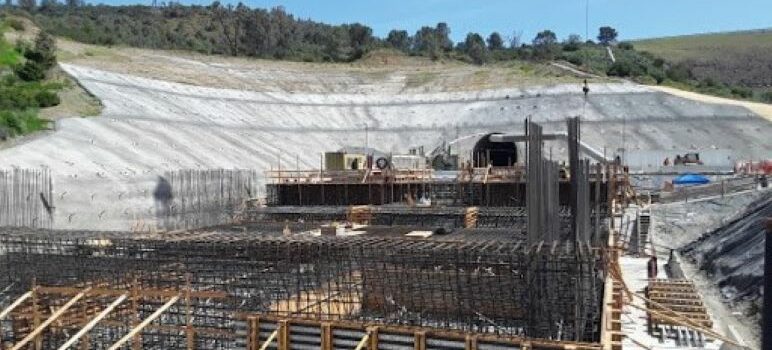Projected costs of the massive Anderson Dam reconstruction project in Morgan Hill have risen to approximately $2.3 billion, according to a report prepared by engineers for the Santa Clara Valley Water District.
Two years ago, the cost of the dam project—required for earthquake protection and improved flood control for the Coyote Creek watershed—was estimated at $648 million. That nearly doubled last year, to $1.24 billion. The Valley Water board of directors is now looking at a new estimate of $2.3 billion, more than triple the 2021 price tag.
The draft cost estimate was submitted to the regional water district in September.
“Several factors contributed to the increase in the construction estimate,” the report said. “Risk reduction measures were added, such as the articulated concrete block auxiliary spillways for interim dams and a supplemental bid item for 1-year delay due to a shortened construction season.”
The new cost increase included increased design costs, construction roads and a new spillway design that lengthens the outlet tunnel under construction.
“Current market conditions have been incorporated into the construction cost to reflect significant increases in material costs, such as concrete and steel, and increases in assumed contractor markups for overhead and profit,” the report said.
The independent construction cost estimate was prepared by OCMI, Inc. and is anticipated to be submitted to Valley Water in December 2023.
The new price tag includes $1.9 billion for the dam and spillway construction, plus approximately $400 million for related projects.
The completion date, 2032, has not changed.
The federal Environmental Protection Agency early this year announced $737 million in low-cost loans for the project, but the Valley Water board will be taking a new look at how to pay for the entire project, including possible increases in its wholesale and retail water rates.
Valley Water’s largest water reservoir has been drained to 3% levels.
Anderson Reservoir, built in 1950, is the largest of the 10 water district reservoirs and has a total storage capacity of 89,073 acre-feet (one acre-foot is 325,851 gallons of water, enough to serve two households of five for one year).
Findings of the original seismic stability evaluation completed in 2011 on Anderson Dam indicated that the downstream and upstream embankments could become unstable during a very large magnitude earthquake.


Welcome to the reality of these projects. Just remember, there is no such thing as government waste, it’s just more money ends up in the developers, lawyers, and compliance apparatus. The trick is to make you think its waste, it’s not, its government transfers from you to their friend and future employers. The funny thing is, you want these people to be your landlords.
You vote, you get.
If California High-Speed Rail can balloon so greatly
(Insider: “This is such a pillage of the taxpayers.”)
If VTA-BART to Silicon Valley can balloon so greatly
(There’s no need for anyone to say anything, is there?)
The Dam Builders are just doing more of the same.
But it is reassuring to know that inclusiveness in hiring interns has the water board directors undivided attention, isn’t it?
Second to past paragraph; “… enough to serve two households of five for a year. “
This is a lot of work for so little storage!
Talk about a lot of inflation. Biden is doing a great job.
That number reflects a single acre foot. The ~90,000 acre feet capacity of this reservoir will support 180,000 such homes.
It’s worth a reminder of that evil nuclear Diablo Canyon with all its power put to desalination: 51 Andersen Reservoirs.
That’s 51 Anderson Reservoirs annually, with no end to the Pacific Ocean. There are less ambitious uses envisioned that still provide a lot more water for less money than would be provided to the state south of the Delta than the bypass sought as a key part of the State Water Project. But for now we’ll do with evil dams locally. Carry on.